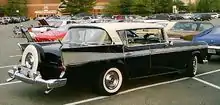Continental tire
A Continental tire or a Continental kit is an upright externally-mounted spare tire located behind an automobile's trunk, made popular by the original Lincoln Continental. The term also describes a non-functional bulge that is stamped into the trunk lid or a cosmetic accessory to the rear of the car giving the impression of a spare tire mount.
Development
.jpg.webp)
.jpg.webp)
.jpg.webp)
The pre-mounted spare tire and wheel combination on early automobiles typically meant an external mounting. Early European sports cars had their spare tire attached on the back of the automobile since their trunk or storage space was often very small.
The development of the enclosed trunk on automobiles meant the spare tire could be placed out of sight, but this arrangement used up valuable space for carrying luggage. Edsel Ford had a special car built after returning from a trip to Europe that would have a "continental look" – including a spare tire mounted on the trunk.[1] The 1939 Lincoln Continental's short trunk with its external rear spare tire mount became a distinctive design. While this was not the first car to either carry its spare above the rear bumper or integrated into the rear bodywork, it was the first to do it so elegantly and thus this feature became known as a "Continental tire" even if the design was found on other brands.[2]
Similar external spare tire placements were added as standard or optional to popular mass-market and also described as a "Continental kit", borrowing their name from the production Lincoln Continental.[3] Consumers were also able to have aftermarket "Continental kits" installed on almost any vehicle. Automotive historians also use this term to describe a nonfunctional circular bulge stamped into the trunk lid to give the impression of a spare tire.[4] This design feature was popularized by several 1950s Italian-bodied Chrysler concept cars.[4] The trunk lid bulge was later embraced by Chrysler designer Virgil Exner and incorporated on the luxury 1957 Imperial and included on the compact Plymouth Valiant by 1960.[4]
There is a legend that Henry Ford II complained that the trunk of his personal Ford Thunderbird did not have room for a set of golf clubs without removing the spare tire.[5] The 1956 Thunderbird had its spare tire mounted outside. However, adding weight behind the rear wheels was said to adversely affect steering and handling.[6] For 1957 the Thunderbird's trunk was stretched 5 inches (127 mm) to allow the spare tire to migrate back inside, although the Continental mounting was still optional.[7] This external spare wheel mount became a customizing aftermarket appearance accessory during the 1950s.[8]
Models

In the United States, the external Continental tire mounting was a factory option on various types of cars during the 1950s and early 1960s. On some models – such as on the Nash Metropolitan, Jeepster Commando, and Mercury Turnpike Cruiser – the Continental tire was a standard feature. Most often, the car's rear bumper was extended and the tire had a fabric or metal cover. The bracket for the spare wheel was designed to swing away for access to the trunk. Manufacturers included Continental tire mounts for their perceived "distinctiveness" as well as a means to increase luggage space in the trunk, such as on all the 1954 Nash Custom models[9][10]
Contemporary examples of Continental kits are sometimes found on customized automobiles. It has become an accessory that typifies "the spirit" of the 1950s.[11] Continental kits were also made popular by the pimpmobile craze of the 1970s, not to mention the Pimp My Ride show. Continental tires are known as 'fifth wheels' in hip hop slang.
Numerous compact sport utility vehicle (SUV) models of today have an exposed rear-mounted spare tire. This is no longer described as a Continental tire. However, the historic Jeep DJ "Surrey Gala" with the fringed top, seats, and Continental tire mount are of colorful vinyl-coated fabrics with "candy stripes" of pink, green or blue to match solid body colors.
 1932 Nash Ambassador Rumble Seat Coupe with matching spare wheel with whitewall tire
1932 Nash Ambassador Rumble Seat Coupe with matching spare wheel with whitewall tire

 Modern version of an outside rear-mounted spare tire on a van or recreational vehicle
Modern version of an outside rear-mounted spare tire on a van or recreational vehicle_Cruiser_wagon_(2011-11-17)_02.jpg.webp) 1998–2000 Toyota RAV4 with externally mounted spare tire
1998–2000 Toyota RAV4 with externally mounted spare tire
See also
References
- Schuon, Marshall (14 October 1990). "About cars: A 50th Birthday For Edsel Ford's Continental". The New York Times. Retrieved 29 October 2020.
- Donnelly, Jim (November 2006). "A Classy Rear". Hemmings Motor News. Retrieved 29 October 2020.
- Auto Editors of Consumer Guide (27 May 2007). "1941 Lincoln Continental". Archived from the original on 2 November 2016. Retrieved 29 October 2020.
- Feibusch, Rick (4 February 2012). "The Continental Kit – That Tire On The Back". Undiscovered Classics. Retrieved 29 October 2020.
- Rothermel, Bill. "History of the Ford Thunderbird 1955-2005" (PDF). artistryinmotion.org. Archived from the original (PDF) on 25 July 2008. Retrieved 29 October 2020.
- D'Argis, Larry. "Thunderstruck" Winnipeg Free Press, May 9, 2008, retrieved on 2008-06-27.
- Vance, Bill. "1955-57 Ford Thunderbird". Canadian Driver. Retrieved 29 October 2020.
- "The Continental History". lincolnanonymous.com. Archived from the original on 28 September 2007. Retrieved 29 October 2020.
- "1954 Nash Airflyte brochure". oldcarbrochures.com. Retrieved 29 October 2020.
- Gilbertson, Scotty (9 June 2018). "All Original! 1954 Nash Ambassador LeMans". Barn Finds. Retrieved 29 October 2020.
- "A lifelong labour of love for Kelowna's continental kit king, The Vancouver Sun, 28 August 2015". continentalkit.com. Retrieved 29 October 2020.
